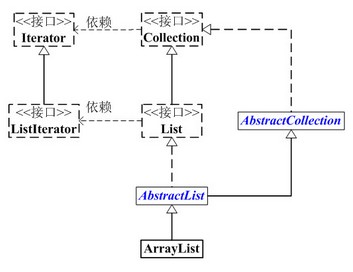标签:
ArrayList是一个数组队列,相当于动态数组。每个ArrayList实例都有自己的容量,该容量至少和所存储数据的个数一样大小,在每次添加数据时,它会使用ensureCapacity()保证容量能容纳所有数据。
ArrayList继承于AbstractList,实现了List, RandomAccess, Cloneable, java.io.Serializable这些接口。
public class ArrayList<E> extends AbstractList<E>
implements List<E>, RandomAccess, Cloneable, java.io.Serializable

ArrayList 与Vector大致等同,唯一的区别就是ArrayList的操作是线程不安全的,然而Vector是线程安全的。所以,建议在单线程中才使用ArrayList,而在多线程中可以选择Vector或者CopyOnWriteArrayList。
对于ArrayList而言,它实现List接口、底层使用数组保存所有元素。其操作基本上是对数组的操作。
private static final long serialVersionUID = 8683452581122892189L; // 使用serialVersionUID验证版本一致性
private static final int DEFAULT_CAPACITY = 10; // 容量的初始大小
private static final Object[] EMPTY_ELEMENTDATA = {}; // Shared empty array instance used for empty instances.
private static final Object[] DEFAULTCAPACITY_EMPTY_ELEMENTDATA = {}; // Shared empty array instance used for default sized empty instances.
// ArrayList数据的存储之地
transient Object[] elementData; // 存储ArrayList中元素的数组
// ArrayList存储数据的个数
private int size;
ArrayList提供了三种方式的构造器方法:
1)通过传入的initialCapacity大小构造ArrayList
public ArrayList(int initialCapacity)
{
if (initialCapacity > 0)
{
this.elementData = new Object[initialCapacity];
}
else if (initialCapacity == 0)
{
this.elementData = EMPTY_ELEMENTDATA;
}
else
{
throw new IllegalArgumentException("Illegal Capacity: " + initialCapacity);
}
}
public ArrayList()
{
this.elementData = DEFAULTCAPACITY_EMPTY_ELEMENTDATA;
}
public ArrayList(Collection<? extends E> c)
{
elementData = c.toArray();
if ((size = elementData.length) != 0)
{
// c.toArray might (incorrectly) not return Object[] (see 6260652)
if (elementData.getClass() != Object[].class)
elementData = Arrays.copyOf(elementData, size, Object[].class);
} else
{
// replace with empty array.
this.elementData = EMPTY_ELEMENTDATA;
}
}
public boolean add(E e)
{
// 1、确保容量大小
ensureCapacityInternal(size + 1); // Increments modCount!!
// 2、尾部添加元素
elementData[size++] = e;
return true;
}
public void add(int index, E element)
{
// 1、检验索引
rangeCheckForAdd(index);
// 2、确保容量
ensureCapacityInternal(size + 1); // Increments modCount!!
// 3、将数据后移
System.arraycopy(elementData, index, elementData, index + 1,
size - index);
// 4、添加元素
elementData[index] = element;
// 5、数组元素个数加1
size++;
}
==>System.arraycopy(src, srcPos, dest, destPos, length);
public boolean addAll(Collection<? extends E> c)
{
// 1、暂存集合c中数据
Object[] a = c.toArray();
int numNew = a.length;
// 2、确保容量
ensureCapacityInternal(size + numNew); // Increments modCount
// 3、尾部添加数据
System.arraycopy(a, 0, elementData, size, numNew);
// 4、数组元素个数更新
size += numNew;
return numNew != 0;
}
public boolean addAll(int index, Collection<? extends E> c)
{
// 1、检验索引
rangeCheckForAdd(index);
// 2、暂存数据
Object[] a = c.toArray();
int numNew = a.length;
// 3、确保容量
ensureCapacityInternal(size + numNew); // Increments modCount
int numMoved = size - index;
// 4、数据后移
if (numMoved > 0)
System.arraycopy(elementData, index, elementData, index + numNew,
numMoved);
// 5、添加元素
System.arraycopy(a, 0, elementData, index, numNew);
// 6、数组元素个数更新
size += numNew;
return numNew != 0;
}
public boolean remove(Object o)
{
// 移除值为null的元素
if (o == null)
{
for (int index = 0; index < size; index++)
if (elementData[index] == null)
{
fastRemove(index);
return true;
}
}
else // 移除元素
{
for (int index = 0; index < size; index++)
if (o.equals(elementData[index]))
{
fastRemove(index);
return true;
}
}
// 值不存在时,移除失败
return false;
}
==>
private void fastRemove(int index)
{
// 1、修改的次数更新
modCount++;
int numMoved = size - index - 1;
// 2、数据前移
if (numMoved > 0)
System.arraycopy(elementData, index + 1, elementData, index,
numMoved);
elementData[--size] = null; // clear to let GC do its work
}
2)删除ArrayList中指定位置上的元素
public E remove(int index)
{
// 1、检验索引
rangeCheck(index);
modCount++;
E oldValue = elementData(index);
int numMoved = size - index - 1;
// 2、数据前移
if (numMoved > 0)
System.arraycopy(elementData, index + 1, elementData, index,
numMoved);
elementData[--size] = null; // clear to let GC do its work
return oldValue;
}
public boolean removeAll(Collection<?> c)
{
Objects.requireNonNull(c);
return batchRemove(c, false);
}
protected void removeRange(int fromIndex, int toIndex)
{
modCount++;
int numMoved = size - toIndex;
System.arraycopy(elementData, toIndex, elementData, fromIndex, numMoved);
// clear to let GC do its work
int newSize = size - (toIndex - fromIndex);
for (int i = newSize; i < size; i++)
{
elementData[i] = null;
}
size = newSize;
}
public boolean retainAll(Collection<?> c)
{
Objects.requireNonNull(c);
return batchRemove(c, true);
}
1)修改指定位置上的元素
public E set(int index, E element)
{
rangeCheck(index);
E oldValue = elementData(index);
elementData[index] = element;
return oldValue;
}
1)获取指定位置上的元素
public E get(int index)
{
rangeCheck(index);
return elementData(index);
}
2)获取指定元素在列表中的第一个位置索引
public int indexOf(Object o)
{
if (o == null)
{
for (int i = 0; i < size; i++)
if (elementData[i] == null)
return i;
} else
{
for (int i = 0; i < size; i++)
if (o.equals(elementData[i]))
return i;
}
return -1;
}
public int lastIndexOf(Object o)
{
if (o == null)
{
for (int i = size - 1; i >= 0; i--)
if (elementData[i] == null)
return i;
} else
{
for (int i = size - 1; i >= 0; i--)
if (o.equals(elementData[i]))
return i;
}
return -1;
}
4)返回某个范围的视图
public List<E> subList(int fromIndex, int toIndex)扩展:java List.subList方法中的超级大陷阱
{
subListRangeCheck(fromIndex, toIndex, size);
return new SubList(this, 0, fromIndex, toIndex);
}
public Iterator<E> iterator()
{
return new Itr();
}
b>
public ListIterator<E> listIterator()
{
return new ListItr(0);
}
扩展:JAVA中ListIterator和Iterator详解与辨析
c>
public ListIterator<E> listIterator(int index)
{
if (index < 0 || index > size)
throw new IndexOutOfBoundsException("Index: " + index);
return new ListItr(index);
}
1)是否为空
public boolean isEmpty()
{
return size == 0;
}
1)清空列表所有元素
public void clear()
{
modCount++;
// clear to let GC do its work
for (int i = 0; i < size; i++)
elementData[i] = null;
size = 0;
}
public Object clone()
{
try
{
ArrayList<?> v = (ArrayList<?>) super.clone();
v.elementData = Arrays.copyOf(elementData, size);
v.modCount = 0;
return v;
} catch (CloneNotSupportedException e)
{
// this shouldn‘t happen, since we are Cloneable
throw new InternalError(e);
}
}
public boolean contains(Object o)
{
return indexOf(o) >= 0;
}
public int size()
{
return size;
}
1)确保容量大小
public void ensureCapacity(int minCapacity)
{
int minExpand = (elementData != DEFAULTCAPACITY_EMPTY_ELEMENTDATA)
// any size if not default element table
? 0
// larger than default for default empty table. It‘s already
// supposed to be at default size.
: DEFAULT_CAPACITY;
if (minCapacity > minExpand)
{
ensureExplicitCapacity(minCapacity);
}
}
2)裁剪容量
public void trimToSize()
{
modCount++;
if (size < elementData.length)
{
elementData = (size == 0)
? EMPTY_ELEMENTDATA
: Arrays.copyOf(elementData, size);
}
}
3)转换成数组
a> 该操作没有涉及到引用,属于安全操作
public Object[] toArray()
{
return Arrays.copyOf(elementData, size);
}
public <T> T[] toArray(T[] a)
{
if (a.length < size)
// Make a new array of a‘s runtime type, but my contents:
return (T[]) Arrays.copyOf(elementData, size, a.getClass());
System.arraycopy(elementData, 0, a, 0, size);
if (a.length > size)
a[size] = null;
return a;
}
参考:
http://www.jb51.net/article/42764.htm
http://zhangshixi.iteye.com/blog/674856
标签:
原文地址:http://www.cnblogs.com/aoguren/p/4756941.html